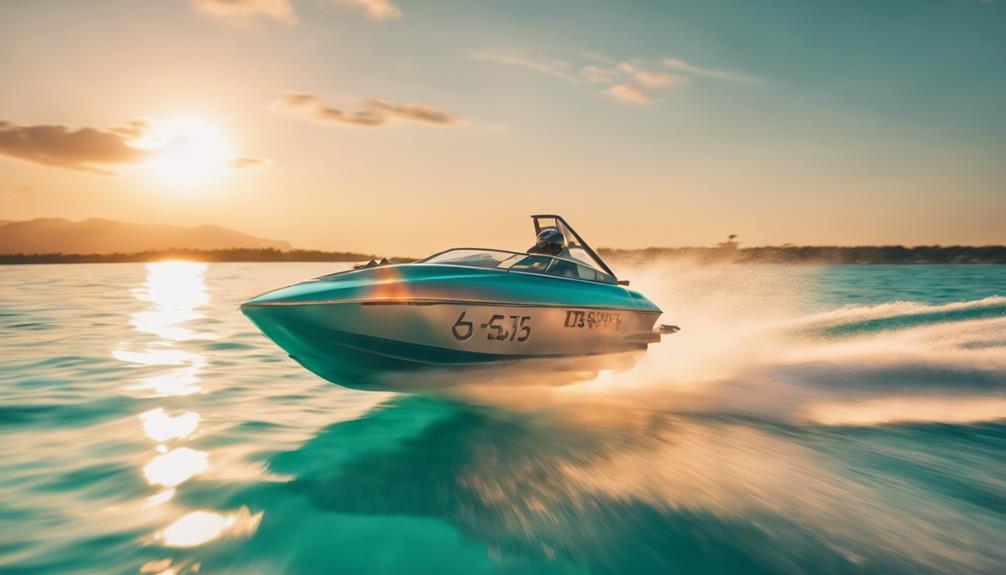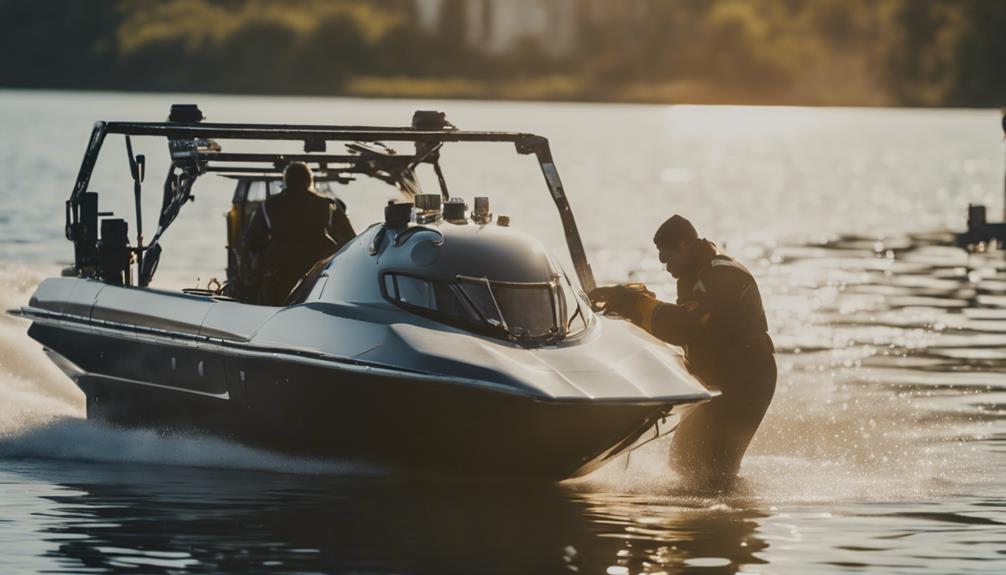Jet boats go in reverse thanks to thrust reversers that redirect water flow. When engaged, these mechanisms allow you to maneuver swiftly, even in tight spots. The engine needs to stay running to keep the impeller spinning, which provides the steering control you need while reversing. Unlike traditional boats that rely on rudders, jet boats utilize continuous water propulsion for quick response and agility. It's important to practice these techniques to build confidence and improve handling. The more you understand this technology, the better you'll navigate your jet boat backward and enhance your overall experience.
Key Takeaways
- Jet boats use thrust reversers to change water flow direction, enabling backward movement when engaged.
- The engine must stay running to keep the impeller spinning, allowing for steering control while reversing.
- Single-engine jet boats require practice for effective reverse maneuvering, while twin-engine models offer enhanced maneuverability.
- Steering in reverse relies on engine power, permitting quick directional changes and agile maneuvering.
Understanding Jet Boat Propulsion
Jet boats rely on a jet propulsion system that efficiently intakes and expels water to create thrust and enhance maneuverability. This system comprises key components like a water intake, driveshaft, impeller, and steering nozzle. When you engage the boat's throttle, the impeller starts to spin, drawing in water through the intake. The impeller then forces this water through a nozzle, generating thrust that propels the boat forward.
The continuous water flow is essential for both speed and steering control, allowing you to make sharp turns and navigate tight spaces with ease. Unlike traditional boats that use exposed propellers, jet boats offer a safer experience by placing the engine inboard, reducing the risk of injury to swimmers or water sports enthusiasts nearby.
When you look at the jet propulsion system, the impeller's constant motion is critical for effective propulsion. To further enhance your control, the reverse bucket can redirect the water flow, allowing you to slow down quickly or even back up.
Understanding these elements guarantees you get the most out of your jet boat experience while appreciating the technology behind its powerful performance.
Mechanisms of Reverse Operation

Understanding how jet boats maneuver in reverse is vital for maximizing their capabilities, especially since the thrust reversers play a key role in directing water flow to facilitate backward movement. When you engage the reverse mode, the jet drive directs water flow in the opposite direction, effectively pushing the boat backward.
It's important to keep the engine running during reverse operation. This guarantees that the impeller remains in motion, allowing you to maintain steering control using the steering wheel. While single-engine jet boats can back up with practice, twin-engine models offer better maneuverability.
Here's a quick comparison of the reverse capabilities of jet boats:
| Type of Jet Boat | Reverse Maneuverability |
|---|---|
| Single Engine | Moderate; requires practice |
| Twin Engine | Enhanced; easier to control |
| Steering Technique | Different from traditional |
| Engine Off | Loss of control |
| Learning Curve | Significant; practice needed |
Maneuverability and Control Features

Maneuverability and control features of jet boats set them apart, making them incredibly responsive and agile on the water. The propulsion systems in jet boats rely on a jet engine that continuously powers the impeller, allowing for quick adjustments in speed and direction. This constant motion enhances maneuverability, even when you're moving in reverse.
Unlike traditional boats, steering in reverse with a jet boat is all about leveraging engine power. You'll find that you can spin on a dime and slide sideways with ease, showcasing the superior agility these vessels offer. This capability is especially useful in tight spots or crowded areas where precision is essential.
However, it's important to remember that mastering these control features requires practice. Users often report different experiences based on their familiarity with the jet boat. The more you practice, the better you'll handle the unique steering dynamics that come with the design of jet engines and their thrust reversers.
With time, you'll gain confidence, making you an adept operator of this remarkable watercraft.
Comparing Jet Boats and Traditional Boats

When you compare jet boats to traditional boats, you'll notice significant differences in maneuverability, especially in reverse.
Jet boats steer by directing thrust, offering a unique handling experience that contrasts with the rudder-based steering of traditional boats.
Understanding these differences can help you choose the right type for your boating needs.
Maneuverability in Reverse
Jet boats excel in reverse, leveraging advanced thrust reversers that provide smooth and responsive backward movement unlike traditional propeller-driven boats. With thrust reversers directing water flow backward, you'll find maneuverability in reverse is greatly enhanced.
Unlike traditional boats, which often require you to bump in and out of reverse for control, jet boats allow for seamless changes, making it easier to navigate tight spaces.
The impeller on a jet boat is always in motion, which keeps your options open even when reversing. The reverse bucket further aids in directing thrust for effective backward propulsion.
If you're operating a single-engine jet boat, you might need some practice to perfect your reversing skills, as the reverse steering may not be as precise as that of inboard boats. However, once you get the hang of it, the maneuverability in reverse will impress you.
For those using twin-engine jet boats, you'll experience even better control and tighter backing capabilities. This dual-engine setup enhances your ability to reverse effectively, making it a preferred choice for those who prioritize agility on the water.
Steering Mechanisms Comparison
Comparing steering mechanisms reveals that jet boats rely on thrust reversers and directional nozzles for agile navigation, while traditional boats depend on rudders for control.
In jet-powered boats, the steering mechanism is centered around the jet pump, which continuously provides thrust. This allows for immediate response when shifting from forward to reverse, giving you a quicker reaction time than propeller-driven boats, which often need to change gears.
However, it's essential to recognize that maneuvering in reverse can be less precise with single-engine jet boats. You'll need some practice to master the controls effectively.
On the other hand, twin-engine jet boats can boast enhanced maneuverability in reverse, as you can independently control each engine, making tight spaces easier to navigate.
While jet boats can back up efficiently, turning off the engine during maneuvers can lead to a loss of steering control, a challenge you typically won't encounter with traditional boats.
Handling Performance Differences
How do handling performance differences shape your experience between jet boats and traditional boats?
When you take the wheel of a jet boat, you'll notice a significant shift in maneuverability compared to traditional boats. Jet boats utilize thrust reversers, which allow for precise control in reverse, unlike traditional boats that often require a clunky bumping in and out of reverse.
Here are a few key points to take into account:
- Responsiveness: Jet boats offer quicker reactions due to their direct engine power, making it easier to steer in tight spots.
- Continuous Impeller Motion: The impeller stays in motion, which enhances your ability to spin and slide sideways, giving you an edge in handling.
Ultimately, while jet boats can outperform traditional boats in specific situations, your familiarity with their operation plays a vital role in optimizing control. Embrace the differences, and you'll likely find the experience exhilarating!
Importance of Practice for Users

When you're learning to operate a jet boat, mastering reverse maneuvers is vital for effective handling.
It's important to practice engine control techniques to maintain steering while in motion, especially in tight spots.
Regular practice not only builds your confidence but also enhances your overall boating skills.
Mastering Reverse Maneuvers
Mastering reverse maneuvers in a jet boat requires consistent practice to build confidence and control. Unlike traditional boats, jet boats rely on a thrust reverser system that redirects the water flow, allowing you to move backward effectively. However, this unique system and the drive shaft's operation demand a different handling approach.
To improve your reverse maneuvering skills, focus on these key aspects:
- Keep the engine running: Maintaining engine operation is vital for steering control while reversing.
- Practice in open water: Start in spacious areas to gain confidence without the pressure of tight spaces.
Many users find that with enough practice, they can execute reverse maneuvers with precision, transforming initial challenges into smooth operations. Your experience will shape your skills, so don't hesitate to spend time honing these techniques.
Mastering reverse maneuvers not only enhances your boating skills but also enriches your overall jet boat experience.
Engine Control Techniques
Practicing effective engine control techniques is essential for gaining confidence in jet boat maneuvering, especially as you master reverse operations. Unlike traditional boats, jet boats rely on engine power and thrust reversers for steering, making your familiarity with these controls vital.
When you engage the thrust reversers, you'll notice how they help push the boat backward. However, it takes time and practice to gain precise control. Remember, the engine must be running for effective steering; turning it off while moving can lead to a loss of steering control, making reversing even more challenging.
Many users experience a significant learning curve when maneuvering in reverse, but don't be discouraged. With continued practice, you'll become proficient, boosting your confidence in docking and managing tight spaces.
As you refine your engine control techniques, you'll notice improved handling skills over time.
Insights From the Jet Boat Community

Jet boat enthusiasts often share valuable insights about reversing techniques that can make managing tight spaces much easier. Many users highlight the importance of keeping the engine running while moving in reverse. This practice not only maintains your steering control but also enhances your overall maneuverability.
Here are a few tips from the community you might find useful:
- Practice in Open Water: Spend time honing your reversing skills away from crowded areas.
- Consider Twin-Engine Models: If you're looking for superior maneuverability in reverse, a twin-engine jet boat is often more effective than a single-engine model.
As you engage with the jet boat community, remember that overcoming the learning curve is part of the journey. With practice and the right insights, you'll find that managing tight spaces in your jet boat becomes considerably easier.
Embrace the shared knowledge, and you'll be reversing like a pro in no time!
Frequently Asked Questions
How Does a Jet Boat Go in Reverse?
A jet boat goes in reverse by using a thrust reverser system, redirecting water flow backward. With practice, you'll learn to maneuver smoothly, making steering easier compared to traditional propeller-driven boats.
How Do Boats Go in Reverse?
When it comes to reversing, boats have their own little tricks. You shift gears, redirect thrust, or adjust water flow—each method creating that backward motion you need for precise maneuvering. It takes practice, but you'll get it!
What Are the Downsides of Jet Boats?
Jet boats have downsides like limited steering precision in reverse, unpredictable thrust, and difficulty in shallow waters. Plus, they require regular maintenance on the impeller, making them more complex and costly if neglected.
How Does Boat Jet Propulsion Work?
Jet propulsion in boats works by pulling water in through a grate, then using an impeller to force it out through a nozzle. This creates thrust, enabling fast acceleration without external propellers.
What Technology Allows Jet Boats to Go in Reverse?
Jet boats are equipped with a unique jet boats reverse feature explained. Unlike traditional propeller boats, jet boats use water-jet propulsion, which allows them to redirect the water flow to change direction. This innovative technology enables jet boats to swiftly and efficiently go in reverse, providing greater maneuverability in tight spaces.
Conclusion
In the end, mastering a jet boat's reverse operation is like revealing a hidden treasure, full of adventure and excitement.
With the right understanding of propulsion and control, you're not just steering; you're dancing on the water's surface.
So, embrace the learning curve and connect with the vibrant jet boat community.
Soon, you'll be gliding effortlessly, leaving behind ripples of unforgettable memories, just like the tales of explorers charting new waters.










